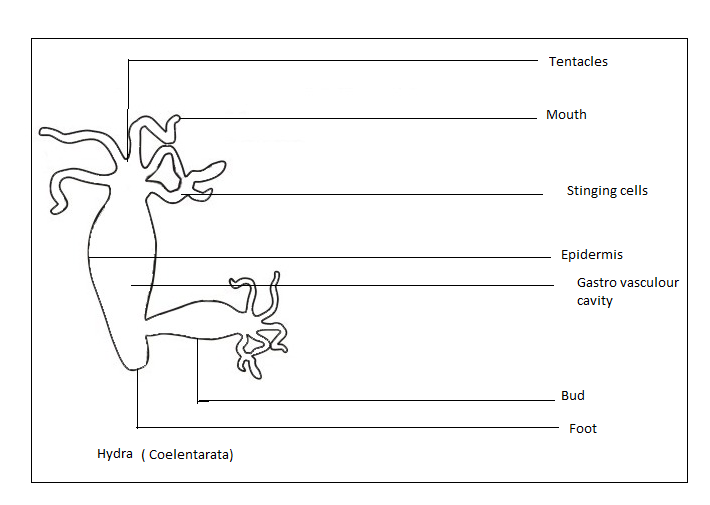
Draw a neat and labelled diagram of Hydra (Coelenterata).
Answer
513.3k+ views
Hint: In, the Cnidaria phylum and Hydrozoa class, Hydra is a genus of small, freshwater organisms. Their native areas are- temperate and tropical areas. Because of their regenerative capacity biologists are particularly interested in Hydra they do not appear to die of old age, indeed to age at all.
Complete answer:
Hydra belong to the phylum Coelenterata, which comprises corals, sea anemones and jellyfish. Coelenterates are mainly aquatic species but in freshwater wetlands, lakes and streams, Hydra are present. Hydra are also typical because they do not have a medusa (jellyfish) period as part of their life cycle, as do most other coelenterates. Only in the tube shape polyp type sexually and asexually, they live and reproduce. They do however, have the microscopic intra cellular stinging capsules characteristics of this phylum and for which it is called, nematocysts or cnidae. Simple as this species are, one of the animal world’s most complex systems is their nematocysts. The four tentacles which the Hydras have, are kinds of nematocysts used for a number of purposes. Like a sock being pulled over a foot, the Hydra then envelops the organism with a tight grip on its foot and consumes it. There are spines running along the thread in the fourth form of nematocyst and are presumably used to protect the Hydra against possible predators.

Note:
Hydra it worms, insect larva, small crustaceans, larva fish and invertebrates; they are predatory. Prior to eating it, to shock, entangle or kill their prey they use their stinging cells. Some Hydra species are also known to sting fish to death. There are barbs in the large nematocysts that anchor the prey to the tentacle from which it was shot.
Complete answer:
Hydra belong to the phylum Coelenterata, which comprises corals, sea anemones and jellyfish. Coelenterates are mainly aquatic species but in freshwater wetlands, lakes and streams, Hydra are present. Hydra are also typical because they do not have a medusa (jellyfish) period as part of their life cycle, as do most other coelenterates. Only in the tube shape polyp type sexually and asexually, they live and reproduce. They do however, have the microscopic intra cellular stinging capsules characteristics of this phylum and for which it is called, nematocysts or cnidae. Simple as this species are, one of the animal world’s most complex systems is their nematocysts. The four tentacles which the Hydras have, are kinds of nematocysts used for a number of purposes. Like a sock being pulled over a foot, the Hydra then envelops the organism with a tight grip on its foot and consumes it. There are spines running along the thread in the fourth form of nematocyst and are presumably used to protect the Hydra against possible predators.

Note:
Hydra it worms, insect larva, small crustaceans, larva fish and invertebrates; they are predatory. Prior to eating it, to shock, entangle or kill their prey they use their stinging cells. Some Hydra species are also known to sting fish to death. There are barbs in the large nematocysts that anchor the prey to the tentacle from which it was shot.
Recently Updated Pages
The number of solutions in x in 02pi for which sqrt class 12 maths CBSE

Write any two methods of preparation of phenol Give class 12 chemistry CBSE

Differentiate between action potential and resting class 12 biology CBSE

Two plane mirrors arranged at right angles to each class 12 physics CBSE

Which of the following molecules is are chiral A I class 12 chemistry CBSE

Name different types of neurons and give one function class 12 biology CBSE

Trending doubts
One Metric ton is equal to kg A 10000 B 1000 C 100 class 11 physics CBSE

What is 1s 2s 2p 3s 3p class 11 chemistry CBSE

Discuss the various forms of bacteria class 11 biology CBSE

State the laws of reflection of light

Explain zero factorial class 11 maths CBSE

An example of chemosynthetic bacteria is A E coli B class 11 biology CBSE




